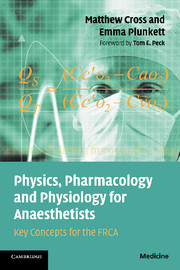Book contents
- Frontmatter
- Contents
- Acknowledgements
- Preface
- Foreword
- Introduction
- Section 1 Mathematical principles
- Section 2 Physical principles
- Section 3 Pharmacological principles
- Section 4 Pharmacodynamics
- Section 5 Pharmacokinetics
- Section 6 Respiratory physiology
- Lung volumes
- Spirometry
- Flow–volume loops
- The alveolar gas equation
- The shunt equation
- Pulmonary vascular resistance
- Ventilation/perfusion mismatch
- Dead space
- Fowler's method
- The Bohr equation
- Oxygen delivery and transport
- The oxyhaemoglobin dissociation curve
- Carriage of carbon dioxide
- Work of breathing
- Control and effects of ventilation
- Compliance and resistance
- Section 7 Cardiovascular physiology
- Section 8 Renal physiology
- Section 9 Neurophysiology
- Section 10 Statistical principles
- Appendix
- Index
Lung volumes
Published online by Cambridge University Press: 15 January 2010
- Frontmatter
- Contents
- Acknowledgements
- Preface
- Foreword
- Introduction
- Section 1 Mathematical principles
- Section 2 Physical principles
- Section 3 Pharmacological principles
- Section 4 Pharmacodynamics
- Section 5 Pharmacokinetics
- Section 6 Respiratory physiology
- Lung volumes
- Spirometry
- Flow–volume loops
- The alveolar gas equation
- The shunt equation
- Pulmonary vascular resistance
- Ventilation/perfusion mismatch
- Dead space
- Fowler's method
- The Bohr equation
- Oxygen delivery and transport
- The oxyhaemoglobin dissociation curve
- Carriage of carbon dioxide
- Work of breathing
- Control and effects of ventilation
- Compliance and resistance
- Section 7 Cardiovascular physiology
- Section 8 Renal physiology
- Section 9 Neurophysiology
- Section 10 Statistical principles
- Appendix
- Index
Summary
Most lung volumes can be measured with a spirometer except total lung capacity (TLC), functional residual capacity (FRC) and residual volume (RV). The FRC can be measured by helium dilution or body plethysmography.
Tidal volume (TV)
The volume of gas which is inhaled or exhaled during the course of a normal resting breath. Also represented by the symbol Vt (ml).
Residual volume (RV)
The volume of gas that remains in the lungs after a maximal forced expiration (ml).
Inspiratory reserve volume (IRV)
The volume of gas that can be further inhaled after the end of a normal tidal inhalation (ml).
Expiratory reserve volume (ERV)
The volume of gas that can be further exhaled after the end of a normal tidal exhalation (ml).
Capacity
The sum of one of more lung volumes.
Vital capacity (VC)
The volume of gas inhaled when a maximal expiration is followed immediately by a maximal inspiration. The sum of the ERV, IRV and TV (ml).
Functional residual capacity (FRC)
The volume of gas that remains in the lungs after a normal tidal expiration. It is the sum of the ERV and the RV (ml).
You may be asked for the definitions above, and to explain them clearly it is often useful to refer to a diagram. You will be expected to be familiar with a diagram of normal respiratory volumes against time, and to be able to explain its main components.
- Type
- Chapter
- Information
- Physics, Pharmacology and Physiology for AnaesthetistsKey Concepts for the FRCA, pp. 115 - 116Publisher: Cambridge University PressPrint publication year: 2008



